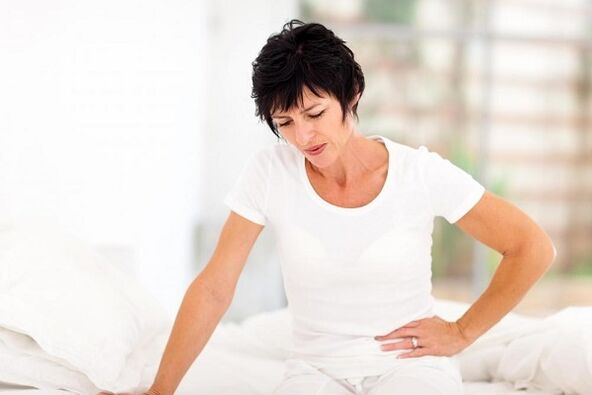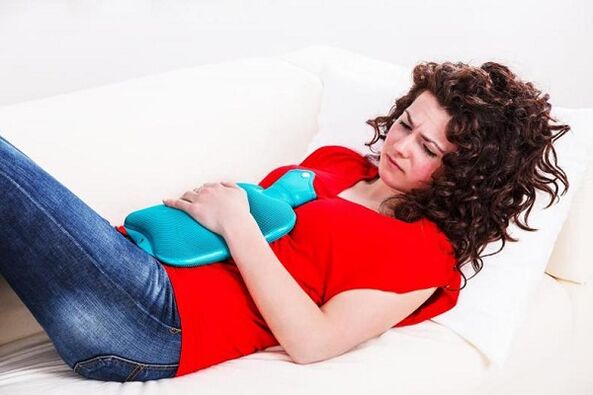The inflammation of the bladder has an infectious nature and leads to a number of unpleasant symptoms under which we can distinguish stretch pain over the pain, frequent, but unproductive urination and blood pollution in urine. The bladder in women needs more emptying than in men. The organ is susceptible to the attacks of viruses and bacteria. Clinical manifestations in any person can differ, it depends on a number of factors: process localization, pathogen, type of disease, severity. What leads to the occurrence of cystitis, how to manifest, what threatens and how you fought it properly?
Causes of cystitis in women

Mostly the cause of the disease are microorganisms that are the natural residents of our body, for example for E. coli. The conditional pathogenic microflora is controlled to immunity that controls the growth and number of microorganisms. If a failure occurs under the influence of certain factors on the operation of the immune system, a conditionally pathogenic flora can get out of control and lead to an inflammatory reaction.
For these reasons, women are susceptible to cysts:
- close location of the vagina and anus;
- The urethra is wide and short.
There are various ways to penetrate pathogens into the bladder cavity:
- ascending. Infection by the urethra penetrated;
- descending. Microorganisms penetrated from the kidneys;
- Lymphogen. Pathic pathogens spread from the pelvic organs;
- Hematogen. This method is quite rare. This means that the infection with a blood flow has come from any organ.
Although bleeding inflammation against the background of other diseases appears most often, the disease can develop in some cases in the form of an isolated process. The reason for this can be the following factors:
- Violation of the rules of intimate hygiene;
- Chronic constipation;
- Avitaminosis;
- wear a child and work;
- Surgical intervention in the urinary bodies;
- Colds, hypothermia, sit on the cold surface;
- Error errors, especially in terms of salt feed;
- the randomness of sexual activity, a common change in partners;
- Kidney diseases;
- hormonal imbalance;
- Diseases that contribute to the weakening of immunity;
- Injury;
- Wear compressing synthetic underwear.
Cystitis is more often a complication of such diseases:
- bacterial vaginosis;
- Candidiasis vaginitis;
- Sexual diseases: gonorrhea, chlamydia, ueapaplasmosis, mycoplasmosis.
Sometimes even medication, especially cytostatics, provokes inflammation of the mucosa of the bladder. Sometimes even an allergic reaction can serve as a trigger mechanism for inflammation.
The first signs of cystitis in women
At the beginning of the disease, the first sign of cystitis in women is a change in urine color. It acquires a certain smell and is cloudy. Urinating calls are also more common. The urine itself is accompanied by unpleasant sensations: complaints or burn. The temperature can rise, but this is not a mandatory sign.
In one way or another, a woman must worry about the first signs of cystitis and get involved with the treatment of the disease.

Types of cystitis in women
Depending on the type of inflammation course, the disease can make up two types:
- Acute cystitis;
- Chronic cystitis.
Cystitis differs in morphological changes occurring:
- Katarrhal;
- Ulcerosa;
- Cystic;
- hemorrhagic;
- Ulcerosa and others.
Depending on the etiological factor, the disease is bacterial, viral, mushroom and not bacterial. The following bacteria can lead to the occurrence of cystitis:
- E. coli;
- Gonorrhea;
- Urea;
- Mycobacteria;
- Staphylococcus or streptococcus;
- Mycoplasma.
Non -bacterial cystitis is divided into:
- allergic;
- Medicines;
- Chemical;
- Beam;
- poisonous.
Symptoms of cystitis in women
Most of the time, bladder infection in women begins strongly and suddenly with the appearance of such signs:
- frequent urge to urinate;
- Pain, rubber, burn;
- Involuntary urinary incontinence;
- the desire to empty the bubble at night;
- During urination, the woman makes a lot of effort and urges;
- Pain occurs in the area of Schubis and Perineum. Sometimes they acquire an unbearable cut in nature;
- Hyperthermia;
- Determination of the general well, weakness;
- Urina receives a muddy color of a purulent nature;
- Hematuria.
Complications of cystitis in women
The complications of cystitis include:
- Hematuria. In some cases, bleeding can develop;
- Interstitial cystitis. The bladder is wrinkled, reduced and its functional activity is seriously injured.
- Pyelonephritis. The expansion of the infectious process along the rising paths can endanger the appearance of inflammatory reactions of kidney structures.
Cystitis with blood in women
Usually urine has a light yellow color. Hematuria can reduce the tone of the muscle tissue of the bladder, a violation of the blood circulation or the inability to empty the bladder over a long period of time. According to statistics, cystitis enters 60% of cases in chronic form. The main error must be drawn! The earlier the treatment of cystitis begins, the better.
The presence of hematuria can indicate the development of cystitis that pose a threat to the patient's life:
- Hemorrhagic. The walls of blood vessels are affected, they become brittle. Most of the time, the introduction of adenovirus or fungus and in the form of a complication of radiation disease occurs.
- gangrenous. In fact, the tissue of the bladder dies. Gangrenous cystitis is dangerous due to the development of blood poisoning. The reason for this state can be some drugs or the presence of a foreign body;
- Ulzerative. Associated with the radial effect on the tumor process. There are often numerous bleeding that threaten death.
Cystitis with blood is accompanied by the occurrence of such symptoms:
- wrong urination;
- The pain becomes so unbearable that a woman takes analgesics;
- Combating pain in the lower abdomen is deprived of sleep and calm;
- a strong rise in temperature;
- Spontaneous urination.

There are different types of hematuria:
- Microgematuria. The blood discharge is insignificant. The patients may not even notice this, but blood is found in a laboratory examination. In most cases, the microgematuria indicates either at the beginning of the inflammatory process or the worsening of chronic cystitis. Sometimes the symptom indicates the presence of injuries in the genitarian area;
- Macroalusematuria. Bleeding are plentiful in nature, which cannot be noticed. Urina becomes scarlet red.
However, the appearance of blood in the urine is a symptom that indicates the presence of a serious injury. It is therefore extremely important to consult a specialist. Hematuria is dangerous for the occurrence of such complications:
- Transfer of other types of infections;
- Violation of the balance of microflora;
- the development of diseases of the urinary system, especially urethritis;
- Blood clots can clog the urinary channels, which emphasizes the urine.
- Stretching and damage to the walls of the bladder;
- Urine incontinence;
- Chronization of the process.
Diagnosis of cystitis in women
The diagnosis is based on clinical and laboratory data as well as echoscopy and endoscopy. The Palpator examination of the Supranelian region is extremely painful.
In general urine analysis, an increased content of red blood cells and leukocytes was found, there is protein, mucus and bacteria. The bacteriological sowing of urine is characterized by frequent growth of pathogens.
Make sure to carry out an ultrasound of the bladder. With cystoscopy you can identify the morphological form of organ damage and identify calculation. Foreign bodies and neoplasms.
Treatment of cystitis in women
Cystitis requires an integrated approach for its treatment. Unpleasant symptoms can pass in a few days when taking tablets, but the infection can hide and at the right time "show your teeth".
Taking pills from cystitis should be combined with the nutrition of the diet. The essence of nutrition is to create gentle conditions for the patient. Do not irritate the inflamed mucous membrane of the bladder of the acute, salty, pickled food and especially alcohol.
But drinking liquid should be as much as possible. Therefore, they contribute to the elimination of the pathogenic microflora and make a urine that is less annoyed by the inflamed organ.
The basic principles of the treatment of cystitis in women include the following:
- The fight against the infectious process;
- Relief of an inflammatory reaction;
- Pain loss;
- Strengthening immunity;
- Saving nutrition and plenty of drink.
Cystitis medication in women
You can forget cystitis with such groups of medication:
- antibacterial;
- anti -spasmodic;
- Probiotics;
- non -steroidal anti -inflammatory anti -inflammatory;
- Phytopers regulations.
Antibiotics
The doctor is involved with the selection of the antibiotic after receiving the data of the bacteriological sowing of urine and identifying the sensitivity to drugs. It is important to undergo antibiotic therapy until the end, otherwise the disease can repeat itself after a while.
Phytopers regulations

The healing effect of medicinal herbs is difficult to overestimate. If former women have collected herbs, dried and insisted on it, there is no urgent need in our time, since herb preparations provided in pharmacies are sold in pharmacies.
Phytotherapy is not mono -agent, but are used in combination with antimicrobial conditions. They improve the therapeutic effect of antibiotics and also reduce the risks of side effects.
Home treatment
Sometimes a visit to the doctor is not possible in the near future. These are exceptional cases, in all other cases when the first symptoms occur, it is important to consult a specialist.
At home you can heal cystitis in a mild form, provided the disease is not accompanied by pain and hematuria. But in this case, too, it is important to undergo an exam and consult a urologist.
It is extremely important that women watch bed rest. The female body should not be revised, it should have the strength to combat the disease.
Folk treatment
Not -traditional recipes enable you to heal bladder inflammation without damage to your health. They are used as a supplement to the main medication therapy and used with the approval of the doctor. Among the popular recipes of cystitis in women are the most common:
- Sitting baths. As a basis, you can take flowers of the pharmacy family. The plant has anti -inflammatory properties that help relieve the symptoms of the disease. The plant is poured and brewed with boiling water. After the decoction has been filtered, it is added to the pool with water. After the procedure, you should wrap yourself and lie down.
- Cranberry. Cranberry juice helps to eliminate the first symptoms of inflammation of the sheet, but this is subject to the primary manifestations of a weakly expressed disease.
- Discokes of medicinal herbs. The collection can be bought with a pharmacy or prepared regardless of such ingredients: Echinacea, Mint, St. John's Würze, Mais -Stigmata, pine buds, bear edge, flat seeds, chamomile, field tail, eucalyptus. Such a collection has an antimicrobial and anti -inflammatory effect.
Cystitis prevention in women
Simple recommendations below will help prevent the appearance of the disease:
- Ideally, there should be a sexual partner. In the case of random connections, it is necessary to use condoms.
- Compliance with the hygiene rules. It is best to use soap with a neutral acid base balance.
- Emphasize the bladder in good time, do not tolerate;
- Try not to become lower, dress in the weather, not to sit on the cold;
- Drink natural water in sufficient quantities;
- Do not wear too tight clothes. Things are laundry for special occasions, but not for daily wearing;
- If you follow your diet, do not allow constipation. Eat fiber that contain fiber, lactic acid bacteria. Kurag, Prunes, fresh cabbage have a laxative.
Diploma
Cystitis in women is a serious infectious and inflammatory disease that delivers enormous symptoms. The disease worsens quality of life and hurts. Cystitis threatens the occurrence of serious complications, sometimes even a danger to the life of the patient. An unexplored disease leads to the spread of the infection process and to the transition of the pathology into a chronic form.
The diagnosis is the first stage of the therapeutic process in cystitis in women. Self -diagnosis can lead to a wrong way, which is why they lose precious time. The treatment of cystitis is involved in a urologist. It includes drug therapy, folk treatment and nutrition of nutrition. Follow all medical recommendations, do not forget prevention and be healthy!


























